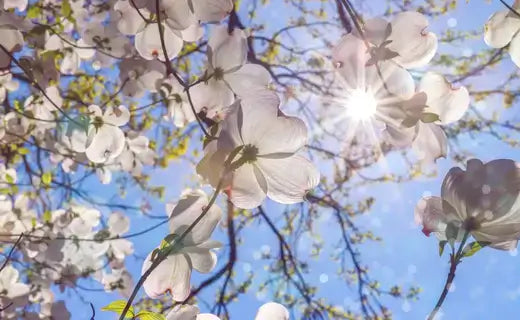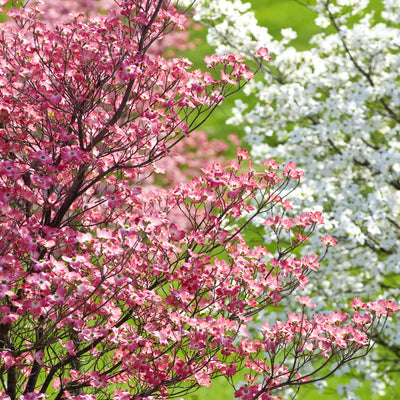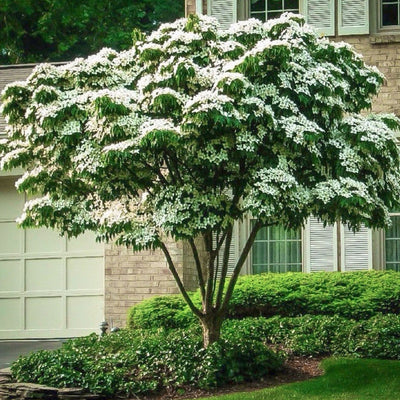A Year-Round Symphony of Beauty
Scientifically known as Cornus Florida, dogwood trees are a cherished and iconic part of the American landscape. These stunning trees have earned their place in the hearts of many due to their distinctive beauty throughout the four seasons. From the delicate blossoms of spring to the fiery hues of autumn and the elegant silhouettes of winter, dogwood trees captivate our senses year-round. In this journey through the four seasons of dogwood trees, we will explore the unique characteristics of different dogwood varieties, including the White Princess, Cherokee Chief, and Kousa Dogwood, and discover tips for appreciating their splendor in every season.
Spring: The Blossoming Beauty
Spring is the season of renewal, and dogwood trees burst forth with vitality during this time. Among the most famous and admired dogwood varieties is the White Princess Dogwood. This elegant tree showcases its enchanting beauty in spring when its branches become a canvas for large, pristine white blossoms. These blossoms are modified leaves known as bracts surrounding tiny, inconspicuous flowers. The sight of a White Princess Dogwood in full bloom is breathtaking, resembling a living work of art. To fully appreciate the beauty of White Princess Dogwood in spring, consider these tips:
- Plant in the Right Spot: Ensure your White Princess Dogwood is planted in a well-drained, partially shaded area. Morning sunlight is ideal, as it enhances the brilliance of the white blossoms without subjecting the tree to harsh afternoon heat.
- Complement with Understory Plants: Underplanting with ground covers and perennials can create a stunning backdrop for the dogwood's white blossoms, enhancing their visual impact.
- Prune Sparingly: Minimal pruning in early spring is recommended to maintain the tree's natural shape and encourage vigorous flowering.
Summer: Foliage and Elegance
The focus shifts from blossoms to foliage as summer arrives, and the White Princess Dogwood doesn't disappoint. Its leaves are vibrant green, creating a lush and inviting canopy. The transition from spring to summer is when the tree truly displays its graceful, rounded shape. In addition to the White Princess, the Cherokee Chief Dogwood is another captivating variety that graces gardens across the United States. In summer, this dogwood's striking red foliage takes center stage. The contrast between the deep green of surrounding trees and the rich red of the Cherokee Chief's leaves is genuinely remarkable. To appreciate the beauty of dogwoods like the Cherokee Chief in summer:
Provide Adequate Water: Dogwoods appreciate consistent moisture, especially during hot summer months. To help retain moisture, mulch around the base of the tree.
Prune to Maintain Shape: Regular pruning should focus on maintaining the tree's structure and removing dead or diseased branches.
Fall: A Fiery Display of Color
As autumn arrives, dogwood trees undergo another transformation. The rich green leaves of summer gradually shift to vibrant red, burgundy, and purple hues. This fiery display of color is a sight to behold and adds a captivating dimension to any landscape. The Cherokee Chief Dogwood shines in the fall as its foliage deepens into a dramatic, eye-catching red. Its brilliant color makes it a standout tree in any autumn garden. To fully appreciate the beauty of dogwoods in fall:
- Plant for Fall Color: When choosing a dogwood variety, consider the colors it offers in the fall. The Cherokee Chief is an excellent choice for those seeking bold, red foliage.
- Prepare for Winter: As fall progresses, take the time to prepare your dogwood for winter. Mulch around the base to protect its roots from freezing temperatures, and consider wrapping the trunk with tree wrap to prevent winter damage.
Winter: An Elegant Silhouette
When winter arrives, and the landscape is stripped of its vibrant colors, dogwood trees continue to enchant with their elegant silhouettes. The absence of leaves reveals the tree's branching structure, which can be incredibly captivating when dusted with snow. One of winter's most resilient and stunning dogwood varieties is the Kousa Dogwood (Cornus kousa). This variety is known for its exceptional cold tolerance and ability to thrive in colder regions. In winter, the Kousa Dogwood's unique exfoliating bark adds visual interest, and its small, spherical fruits persist, providing food for wildlife. To appreciate the beauty of dogwoods in winter:
- Plan for Winter Interest: When designing your landscape, incorporate dogwood trees strategically to ensure they can be appreciated even in the stark beauty of winter.
- Bird-Friendly Planting: Kousa Dogwoods, with their persistent fruits, provide a valuable food source for birds during winter. Consider planting them in proximity to bird feeders or birdbaths.
The four seasons of dogwood trees offer a year-round symphony of beauty. From the pristine blossoms of spring to the fiery foliage of autumn and the elegant silhouettes of winter, dogwood trees enrich our landscapes every season. Varieties like the White Princess, Cherokee Chief, and Kousa Dogwood each contribute their unique charm, making them beloved additions to nationwide gardens. Following the recommended tips for each season, you can ensure your dogwood trees thrive and continue to enchant with their ever-changing beauty.



